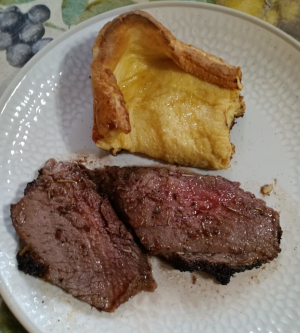British Entree
ROAST BEEF WITH YORKSHIRE PUDDING
3½ pounds top sirloin or rib roast
1 teaspoon pepper
1 teaspoon salt (¼ teaspoon more later)
2 garlic cloves
3 tablespoons olive oil
½ tablespoon rosemary
INGREDIENTS – YORKSHIRE PUDDING
4 eggs
1 cup flour
¼ teaspoon salt
1 cup milk
SPECIAL UTENSILS
wire rack
roasting pan
cooking thermometer
aluminum foil
8″ * 8″ casserole dish
MEAT DONENESS
This recipe assumes that the center cut will be medium-rare and the end cuts more well done. But you can roast to your desired level of doneness. A rule of thumb has the following meat temperatures for the following cuts: Rare = 125, medium rare =135, medium = 145, medium well =155, and well done = 160.
Serves 8. Takes 2 hours 15 minutes.
PREPARATION – ROAST BEEF
Preheat oven to 475 degrees. Rub sirloin with pepper and 1 teaspoon salt. Mince garlic cloves. Add garlic, olive oil, and rosemary to small mixing bowl. Mix with fork. Rub sirloin with olive oil/garlic mixture.
Put wire rack in roasting pan. Put sirloin on wire rack. Roast at 475 degrees for 20 minutes. (Roasting is similar to baking but at a higher temperature.) Reduce heat to 375 degrees and roast
until meat thermometer in middle of sirloin registers your desired level, about 1 hour. (Please note that different ovens and different thicknesses of meat will make roasting time vary. Pay attention to the meat thermometer.) Place roasted sirloin on plate and cover with aluminum foil. Save drippings.
PREPARATION – YORKSHIRE PUDDING
After you put sirloin to oven, add eggs to cup. Beat eggs with whisk. Add flour and ¼ teaspoon salt to large mixing bowl. Mix with whisk. Add eggs. Mix with whisk until well blended. Gradually pour in milk, whisking while doing so until you get a smooth batter with the thickness of heavy cream. Let sit until roast beef needs to be removed from oven.
After removing roast beef from oven, raise oven temperature to 425 degrees. Add ¼ cup reserved drippings to casserole dish. Put casserole dish in oven. Heat drippings for 15 minutes or until drippings start to smoke. (Save drippings remaining after this step. Put casserole dish on stove top. (Carefully! The casserole dish contains hot oil.) Ladle batter to casserole dish. (Again, do this carefully.) Bake at 425 degrees for 15 minutes or until batter puffs up and becomes golden brown.
PREPARATION – FINAL
Ladle any remaining drippings over roast beef. Carve the roast beef. (End cuts should be more well done than the center cuts.) Serve roast beef and Yorkshire pudding right away.
TIDBITS
1) The above picture shows a corner piece of the Yorkshire pudding. Notice how two edges of this piece puff up way higher than the rest of the pudding. In fact, doesn’t the entire corner piece look like a meadow full of golden wheat ripe for harvesting all set against two majestic mountains?
2) This is no accident. People have want to know what different places of the world looked like. Before the age of cameras, the only real way to depict landscapes and mountains was to paint them. But painting was slow and laborious. Making pigments for the paint colors cost lots of money. Finding the proper clays and pigment bases proved daunting as well.
3) By the time the client who’d commissioned a field of grain swishing in the wind before the Alps, he could already traveled to the Alps. Alps painting languished. Travel to Switzerland fell to zero.
4) Then in 1777, Chef Hans Gasthaus made Yorkshire Pudding for some British nobility. Hans noticed his pudding looked exactly like the wheat field and Alps outside the kitchen window. Hans journeyed from Alpine town to Alpine town skillfully making Yorkshire pudding that looked exactly like the local fields and mountain. He ‘dlet these creation dry out and send them to British tour guides.
5) Penurious British lords took to displaying their pudding art in their manors. After all, pudding art cost much less than a painting. Other chef painters turned out great pudding sceneries. It was the golden age of Yorkshire Pudding landscapes.
6) Alas, the French Revolution and the Napoleonic wars soon broke out. These bloody wars ruined everything. Flour, milk, and eggs which had powered the Yorkshire Pudding Landscape Revolution (YPLR) got diverted to feed the rampaging armies on the continent.
14) Yorkshire Pudding Art died forever. Our world became forever grayer. Hardly any (YPLR) examples remain. But if you can find an antique Yorkshire pudding, keep it. They’re worth millions.
Paul De Lancey, The Comic Chef, Ph.D.

Check out my latest novel, the hilarious apocalyptic thriller, Do Lutheran Hunks Eat Mushrooms? It’s published by HumorOutcasts and is available in paperback or Kindle on amazon.com


